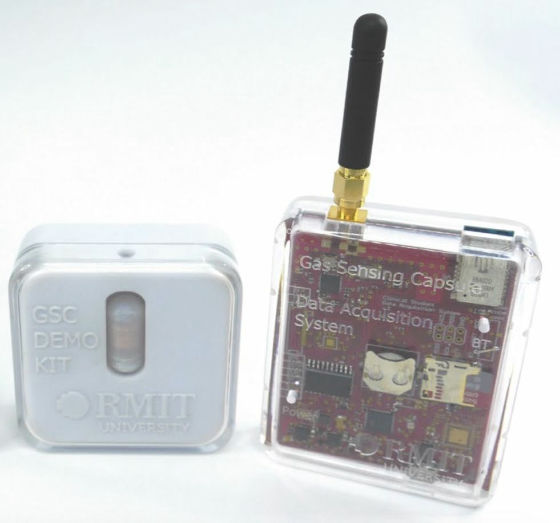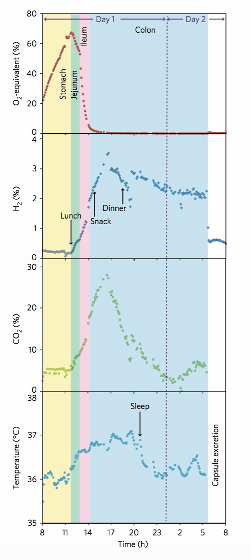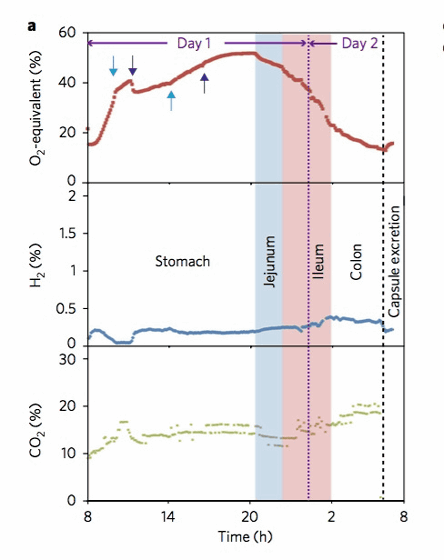A tablet type device appears that can track fart changes in the body from smartphones

The intestine is called the "second brain", and what the person wants to eatTo controlIn addition to being said,Anxiety and depressionIt is said that it is also related to it, and monitoring the intestinal environment is thought to provide great health benefits. Under such circumstances, technology to monitor gas changes in the intestines with smartphones was developed by swallowing a capsule like a large vitamin.
A human pilot trial of ingestible electronic capsules capable of sensing different gases in the gut | Nature Electronics
https://www.nature.com/articles/s41928-017-0004-x
Swallowable sensors reveal mysteries of human gut health | EurekAlert! Science News
https://www.eurekalert.org/pub_releases/2018-01/ru-ssr010218.php
With ingestible pill, you can track fart development in real time on your phone | Ars Technica
https://arstechnica.com/science/2018/01/with-ingestible-pill-you-can-track-fart-development-in-real-time-on-your-phone/
A research team headed by Kourosh Kalantar-Zadeh of the Royal Melbourne Institute of Technology in Australia and Mr. Peter Gibson of Monash University developed a capsule-type device that monitors gas levels in the intestines. It works in conjunction with two pocket-sized receivers and smartphone applications, and when taking capsules it shows real-time the situation in the body from the stomach to the intestines.
As of the year 2018, the capsule-type device was in the stage of a small-scale clinical trial, researchers said, "Our clinical trials are intestinal itself, healthyMicro-biomeIt showed that there are great possibilities for electronic devices to detect gas in understanding how the body responds to changes in dietary habits. "
The information on what is going on in each part of the digestive system is complicated, so far it has been difficult to gather data such as "which bacteria are increasing" and "what food is causing problems" And was part. Up to now it has been done by the method of "collecting gas using a tube", etc., and researchers seem to have found great possibilities in the same device because there are few rival existence.
In animal studies using pigs, researchers used capsules with a total length of 26 mm and a diameter of 9.8 mm. This capsule has sensors for temperature, carbon dioxide, hydrogen, oxygenSilver oxide battery, Equipped with transmission system. Also, a shell made of polymer was used on the outside. A membrane permeating gas is used on one side of the capsule so that gas in the intestines can be picked up as soon as possible. I heard that the clinical trial used an improved capsule used in animal experiments.

This is a capsule type device.

Body device and polymer shell can be separated.

The receiver looks something like this.

As a result of using six capsules by a healthy person, the capsule stayed in the stomach 4.5 hours, the one who stayed in the small intestine was 2.5 hours, and the one who stayed in the large intestine was 13 hours in total, 20 hours It seems that it was a trip. And researchers used ultrasonic waves to tie the gas information of the place "where the capsule is located in the intestine", "When the levels of carbon dioxide and hydrogen are in the large intestine Peak arrives as soon as it arrives. "It turns out that" the level of oxygen is low throughout the large intestine. " This is consistent with anaerobic bacteria in the intestine.

In another clinical trial, one subject had a capsule twice. This subject was asked to eat more dietary fiber in the 2 days before drinking the first capsule and two weeks after that we had a meal with less dietary fiber for 2 days and then had the second capsule drunk It was.
When we eat a lot of dietary fiber, it took 23 hours for the capsule to pass through the body of the subject. Although diet with many dietary fiber is generally recommended, subjects at this time had abdominal pain due to ingestion of dietary fiber in large amounts. Monitoring inside the gastrointestinal tract with a capsule found that the oxygen level in the intestine was rising and that the intestinal tract, which should be an anaerobic environment, was originally disturbed. Analysis of bacterial bacteria later revealed that the number of seeds considered not good for intestinal health had increased.

On the other hand, problems were confirmed even when dietary fiber was small. First, it took three days for the capsule to drain out of the body. At this time, the time the capsule stayed in the stomach was 13 hours, the small intestine was 5.5 hours, the large intestine was 54 hours. Because the capsule did not move too much, the subjects ingested a large amount of dietary fiber 36 hours after capsule ingestion. Until additional intake of dietary fiber was done, the hydrogen level in the large intestine was extremely low, and it seems that fermentation work did not progress well.

In the third clinical trial, two of the four healthy subjects had meals with a large amount of dietary fiber, and the other two had meal less dietary fiber. As a result, it was shown that the data in the digestive organ indicated by the device is similar to the second clinical trial.
Researchers are looking for cooperating companies to develop further clinical trials and devices as they write articles.Microorganism group present in human intestine "Microbiome"Since it is considered to have a major influence on health, the research is regarded as having great potential.
Related Posts:







